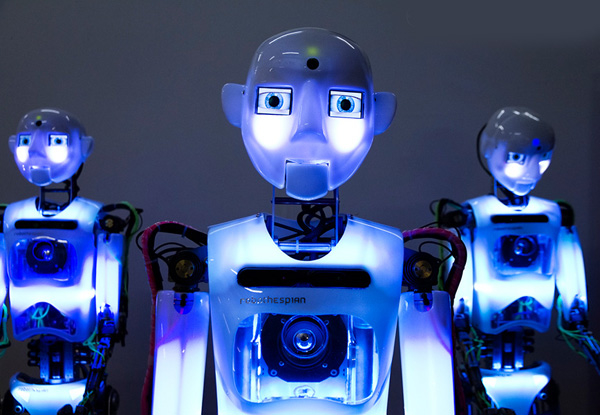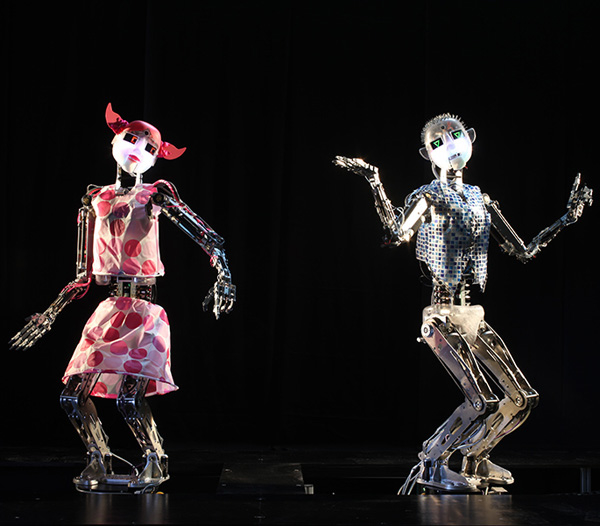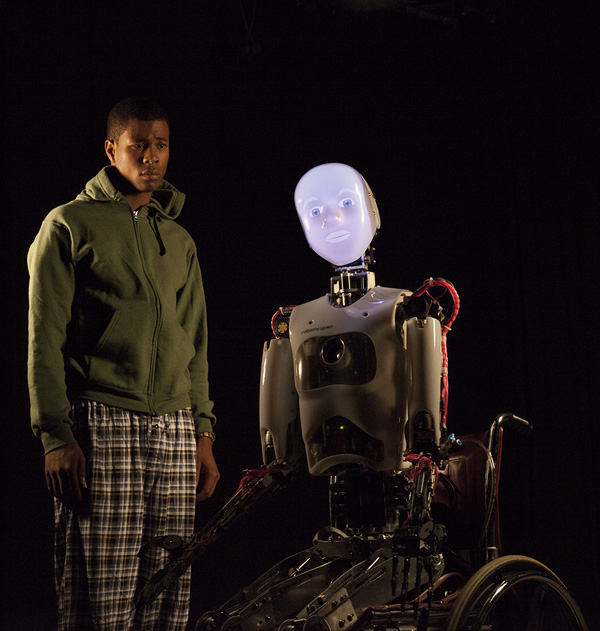Are Robotic Actors the Future of Live Theater?
”And the winner of the 100th Annual Tony Award for Best Actor in a Musical is…RoboThespian™!”

(© Engineered Arts)
"It's in our nature to see life, personality and intention where none exists," states the website of Engineered Arts, a robotics company operating in Penryn, England, that manufactures the world's first commercially available mechanized actor. "RoboThespian™ exploits this desire; it is an anthropomorphic machine, a dot on the graph that starts with automata, and will end when we are no longer able to distinguish the living from the mechanised." Such foreboding language might call for a thunder clap as punctuation, rather than a period. Are robots really coming to replace humans on the stage?
It was Karel Čapek's 1921 science fiction play R.U.R. that introduced the word "robot" to the English language. It seems only fitting that that spearhead of the eventual robot takeover would begin in the theater.

(© Engineered Arts)
Will Jackson is the founder and director of Engineered Arts. While you might expect a Dr. Frankenstein type operating out of a Cornish castle overlooking the English Channel, Jackson comes across as quite humble, personable, and infinitely realistic about the practical use of RoboThespian. He began developing the theatrical android in 2005, not as an actor per se, but a tour guide. "I was doing a lot of science education and we were trying to come up with a way of engaging people — delivering a message," he explained about his initial impetus to design a robotic actor. "The best way to do it is to stand there and tell people. Nobody wants to stand there and tell people the same thing over and over again all day; we thought, Hey, this is the kind of job a robot can do."
So Jackson and a small band of engineers created RoboThespian, a humanoid robot designed to stand and deliver. It can't walk, but it is excellent at answering questions (provided they are within its programming) and remaining in place for hours on end without ever taking a coffee break. He sells about 15-20 a year, mostly to universities and museums to be featured as automated guides in displays and presentations. That doesn't mean it can't be used for more artistic purposes, however.
For the Saudi prince or Russian oligarch who has everything, Engineered Arts offers a pre-packaged "Theatre of Robots," which comes complete with three RoboThespians, a lighting and sound system, and a stage outfitted with tracks to move the robots on and off. (Remember, they can't walk.) Presently, only one Theatre of Robots exists in the world, at the Copernicus Science Centre in Warsaw. "It's been fantastically popular," Jackson said. "They have a number of plays and they run shows continuously every hour and have for the past five or six years." By contrast, most Broadway shows perform eight times a week and never more than twice a day.
Click below to see RoboThespian acting in Polish:
While fully robotic plays are still a rarity, integrated human-robot casts are becoming less so: Writer and director Francesca Talenti recently featured a RoboThespian in her new play, The Uncanny Valley, at the Brick Theater. It tells the story of Edwin, a victim of identity theft who agrees to upload his personality to a robot in exchange for great riches. I asked Talenti if there was something specific that inspired her to pen this Faustian tale.

(© Paul Davis)
"Oh yeah! The robot," she said. "I wanted to actually put it in a play to see what it could do." Talenti teaches filmmaking at the University of North Carolina at Chapel Hill, but she's recently moved into the world of live performance, designing media for a production of Hamlet at Washington, D.C.'s Folger Theatre. When she discovered that UNC had purchased a shiny new RoboThespian, she leapt at the chance to give it a test drive.
She enlisted the help of a postdoctoral student in computer science to write code that would allow the RoboThespian to perform a full-length play. "It's a lot more work than just directing an actor," Talenti explained, "We had to construct a performance from scratch." That means specifically programming every line reading, gesture, and expression. While auteurs like Robert Wilson and Richard Foreman might salivate at the prospect of such total control, most directors thrive on the creative input and intelligent choices of their actors.
And then there's the issue of price: A basic RoboThespian retails for £55,000 ($86,430). That's a lot of money, but it's far more affordable than similar humanoid robots on the market. (Honda's Asimo, arguably the most famous humanoid robot, runs upward of $1 million.) "It was really important for us to produce an affordable robot," Jackson said. "If you spread the cost of the robot over a large number of visitors, the economics make sense. It's like putting on a Broadway show. You have to consider how many tickets you're selling versus the cost of production."
He may be correct when it comes to museums and attractions like NASA's Kennedy Space Center (a proud owner of a RoboThespian), but when it comes to live theater, human actors are still the more affordable option. (A recent Equity casting call for a prominent New York City theater company advertised $357 weekly compensation for performers.)

(© Engineered Arts)
And for now, flesh-and-blood actors are still more reliable. "I'd rather direct humans! Hands way down," said Talenti. "There's always all this crap that can happen with the robot. We had to cancel our opening night because we ran into this crazy problem that we couldn't solve in time. It was mortifying."
If Talenti's experience is any indication, we've barely touched off from the y-axis on Jackson's graph that leads to robots being indistinguishable from humans. Jackson is clear-eyed about that fact, or the notion that he'll ever see a convincingly human robot in his lifetime. "I've spent most of my life on it, but it's more than one person can do," he said with a twinge of resignation.
Of course, he's not alone. Engineered Arts now has 18 full-time staffers and they've just had their best year ever when it comes to orders. This March, they plan to unveil Byrun, a bipedal robot that can walk like a real actor. "We get blasé about it because we're around robots all day," Jackson said. "But when people walk into the workshop see the robots for the first time, they freeze and stand there, jaw-dropped. You realize the impact of that." RoboThespian may be a triple threat some day, but first it has to learn how to walk.
So fear not sentient actors: Economics, reliability, and the ability to dance are still in your favor…for now. Of course, if larger trends in consumer electronics (lower prices, better performance) carry over to robots, expect to see a whole lot more RoboThespians on a stage near you in the not-too-distant future.
Click below to see RoboThespian performing "Singin' in the Rain":








